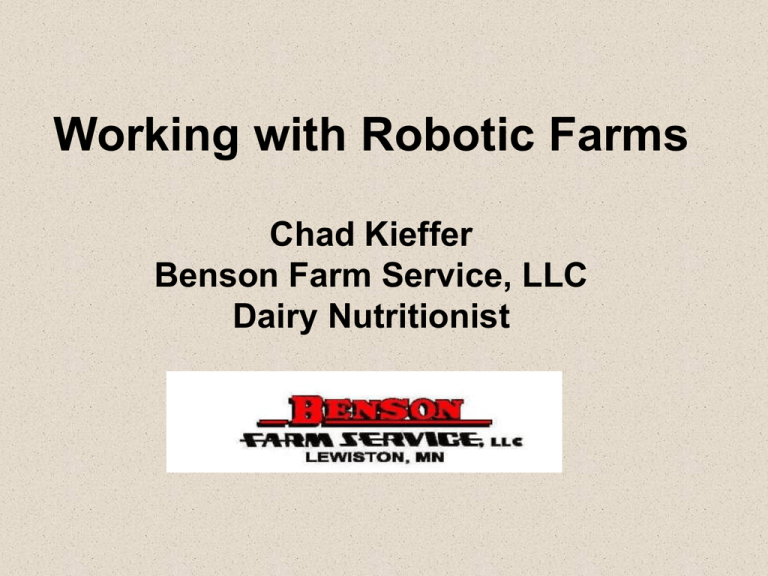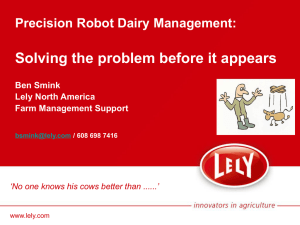Background of Kiefland Holsteins
advertisement

Working with Robotic Farms Chad Kieffer Benson Farm Service, LLC Dairy Nutritionist Pic of farm and pic of robots Background of Family Dairy Before robots: -milked 270 cows in a double 10 parallel parlor -6 full time employees After installing 3 Lely A3 robots: -milk 175 cows on the 3 robots -milk other 100 cows in parlor -within next year will go to 5 robots -Currently 4 fulltime employees Background of Family Dairy • One Robot = 4,500 – 5,500 lbs milk per day (Ideal) • Currently: 58 cows/robot X 86 lbs/cow = 4,988 lbs/robot • 2.9 – 3.1 Average Milkings per cow/day • Free Flow System • Pelleted grain/protein mix in robot, PMR in bunk What the Lely Robot measures: Activity* Rumination* Feed intake Weight * = option Milk yield Milk speed Milk Fat Milk Protein Robot visits Box times Per Quarter: - Pre Milk Time - Milk Time - Conductivity - Color + combinations of all of that ... + combinations with calendar and health events. Nutrition Preparation for Startup • Top-dress robot pellet in parlor 1-2 weeks before startup – IDEAL • Top-dress robot pellet on top of TMR when fed in bunk twice/day for 1-2 weeks - OK Things to Remember & Do as a Nutritionist for Startup • What producer feels: At startup 3 days of hell, 3 weeks of frustration, 3 months before things start clicking • 1) 2) 3) 4) What to provide to producer: Assist with pushing cows first couple days Make regular weekly visits first 3 mo. Moral support (very emotional time) Watch graphs very closely each few days Things to Remember & Do as a Nutritionist for Startup • Do not look at milk production first as a performance indicator • Look at refusals and # of milkings/day first and foremost, then production • Get away from thinking on a herd level (one group ration) • Feed hfrs and cows differently in robot • Lots of info available, so make adjustments quicker than used to if needed Nutrition Preparation for Startup • 1) Feed Speed: Optimum setting is 14-16 oz/minute (depends on if pellet or meal, meal lower and pellet higher) • 2) Max & Min lbs feed/visit: 4-6 lbs max setting, 0 for min setting (default) (this is set based on herd production and feed table settings) • 3) Must have feed tables set up correctly to herd parameters (Jeff will talk about) Cornerstones of Feeding for Success • 1) Ration fed at bunk is based on avg milk yield per cow minus 15 lbs. (even more for startup, 20-25 lbs) • 2) Robot pellet should be fed at min. of 4 lbs and a max. of 18 lbs in robot (approx). • 3) Have a good hard pellet that is palatable and smells good to the cow. “Motivation for a cow to visit the robot is not due to pressure of udder but the want and need for concentrate.” Unsuitable ration Energy requirement Collecting cows -> Energy Concentrate Energy content feed fence: average milk production 0 0 -> time in lactation Most suitable ration Energy requirement -> Energy Collecting cows Concentrate Energy content feed fence: average milk production minus 7 kg (15 lb) 0 0 -> time in lactation Example Robot Pellet Ingredient Composition Description Percent Lbs. Lbs/cow GR CORN FINE 39.990 799.800 4.40 SUREPRO (LOL) 25.000 500.000 2.75 GR SOY HULLS MXDML 12.600 252.000 1.39 DEHULLED SOYMEAL.. 12.428 248.558 1.37 DDGS ETHANOL 4.329 86.584 0.48 MOLASSES.MXD MEAL 2.510 50.200 0.28 AMERI-BOND 2X BG 1.043 20.858 0.11 DRY MOL NUTRI SRCE 1.000 20.000 0.11 CWG FA 1.000 20.000 0.11 AGRI-SWEET 0.100 2.000 0.01 100.000 2000.000 11.00 Nutrition Guidelines • 1)Refusals: (avg # of times per day cow enters robot and can’t be milked yet) Above 1= doing well >1.5= sign of good diet but can push energy in PMR to get more milk <.8= feed in PMR an issue or displeased with robot or pellet <.4= larger herd issues or robot setting problems Nutrition Guidelines • 2) Rest Feed: (lbs of feed eligible to cow but never dispensed per day) • Goal: Should be half of the number of cows per robot • Look for if incorrect: – Who is causing the rest feed? – Are milkings low per cow? – Are settings correct? Nutrition Guidelines • 3) Rumination: (# minutes chewing) Goal 450-550 min. avg for herd • • If >550: too much fiber in diet or full fill If <450: concentrates or starch possibly too high Possible adjustments: • Change PMR • Adjust amount of robot feed fed • Rumination reliability should be 85 or higher on each cow if not adjust responders or bad responder Achievement Important: • • • • > 2.5 milkings a cow per day > 1.0 refusal a cow per day < 5 failed milkings per robot per day >10% free time on the robot Labor Cost vs. Robot Cost Compare Labor Cost vs. Robot Payment Robot - $180,000 @ 6.5% Int for 7 yrs Payment of $32,819 / yr *Data from Tom Anderson (FBM Instructor) Labor Cost vs. Robot • Robot: 4700 # per day = 1,715,500 Annually Or: 17,000 cwts • So: $33,000/17,000 cwts = $1.94 / cwt • Or 5500 #/day = 20,075 cwts or = $1.64/cwt. Labor Cost vs. Robot • One FTE – (Full Time Equivalent Person) Should produce: 1,000,000–1,200,000 Pounds of milk annually. • Remember the Robot: 1,700,000+ # Annually So the robot is replacing more than 1 FTE Equivalent. Labor Cost vs. Robot • Conventional Farm 1 FTE should manage 47 cows • Robot Farm 1 FTE should manage 110 cows (this is still a question??) Robotic Milking Technology Trends I am Seeing in Robots: 1. 2. 3. 4. 5. 6. 7. 8. Increased production – Similar 2x to 3x Equal or improved SCC counts Herd health improving Lower Turnover rates Increased invent–market for robot cows Networking of Robotic users Movement to larger operations Increased Pg rates Questions??





